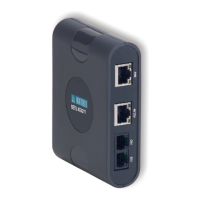Matrix SETU ATA211 V1 System Manual 53
• Click on 'System Parameter' link and program 'Play Routing Tone?' flag as per your requirement.
• 'Play Routing Tone' flag will be applicable only when call is made from FXS to FXO port during Multi-
Stage Dialing. (Refer chapter “System Parameters”to enable/disable playing routing tone)
• Routing Tone will be played only on FXS port when 'Play Routing Tone' flag is enabled. When caller is
calling using the SIP account, routing tone shall not be played (user will get silent) on SIP.
In the above scenario, if extensions of PBX1 want to reach the extensions of PBX2 by dialing 22 + Extension
Number (of PBX2), program the Dialed Number List-01 and Substitute Number List-02 (at calling side ATA
viz.ATA1) and as follows: (Refer web page for ANT)
• Ensure that 'Automatic Number Translation (ANT)' is enabled on SIP Account from where you want to
route the call.
• Keep 'DTMF ON and OFF Time' and 'Play Routing Tone?' parameters to default values if you don't have
any specific requirement.
• Now when any extension user of PBX1 dials '22 + Extension Number (of PBX2)' say 22101 (to reach the
extension 101 of PBX2),
• ATA1 will first dial out the ATA2 number viz. 22 and wait for answer. Caller will only hear routing tone.
DID/Auto-Attendant must be enabled on the FXO port of PBX at called side viz. PBX2.
• Once the call has been matured, ATA1 will send the remaining number viz. 101 in RFC 2833 (Outband)
to called device viz. ATA2.
• These DTMF digits are then detected by PBX2 on its FXO port and will place the call to extension 101.
• In the above scenario, if you want some delay after call gets mature and before ATA211 sends the
remaining DTMF digits, program '22~^' in Substitute Number List instead '22~' only.
• Similar programming is required to be done in each ATA211 connected at other sites.
Number List INDEX1 .. INDEX24
01 22
02 22~
03
:
08

